Mail.dat Splitter Plug-In
The Mail.dat Splitter plug-in is used to run the ‘wbMDMgr.exe’ program which imports Mail.dat files into an MS SQL Server database, which can then be split into multiple Mail.dats according to specified criteria and exported for use.The exported Mail.dats can then be imported by DAT-MAIL or any other post-presort software.The plug-in also allows the Client to configure the pre-process splitting of the Client’s Mail.dats before they are imported into DAT-MAIL.
To configure the Mail.dat Splitter plug-in, do the following:
-
Open Scheduler and
 Stop the Service.
Stop the Service. -
Click Mail.dat Splitter on the left.
The Select Configuration screen will display.
Select the Expert View checkbox and click Next to continue.
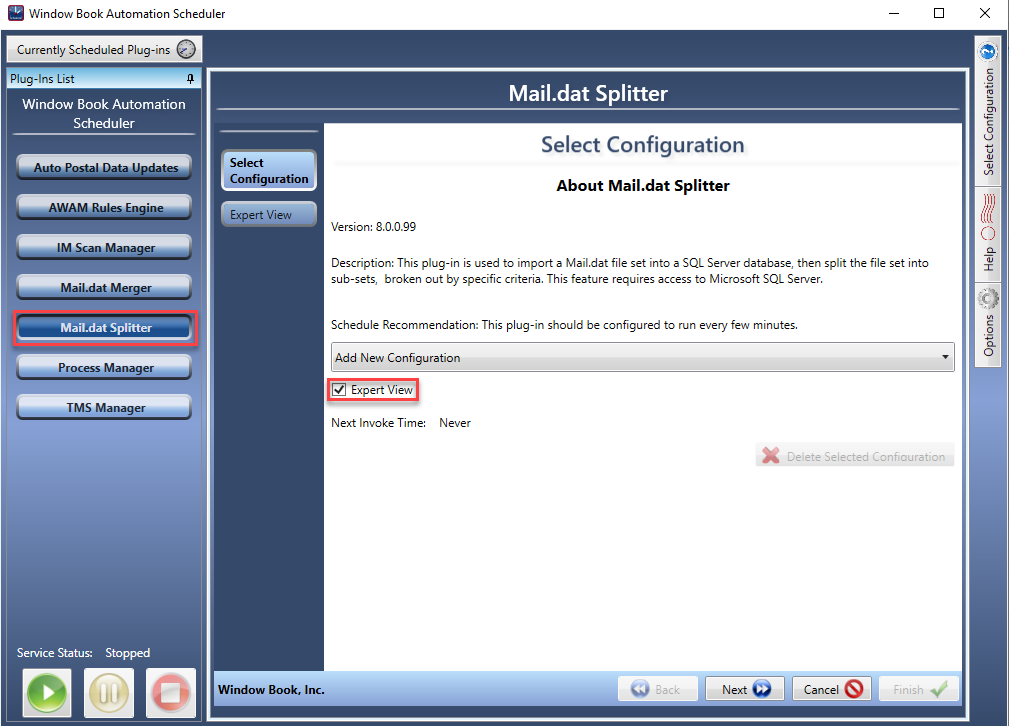
-
The Expert View screen will display. Enter a
 Name specific to the configuration being created and specify when and how often the plug-in’s process will run. Click Next to continue.
Name specific to the configuration being created and specify when and how often the plug-in’s process will run. Click Next to continue.Window Book does not recommend enabling the function to Run at start-up unless directed by a Window Book Support representative. However, if this option is enabled and the Scheduler is stopped and started for whatever reason, the plug-in will run every time the Scheduler starts regardless of the plug-in’s frequency settings.
Below the print screen is an explanation:
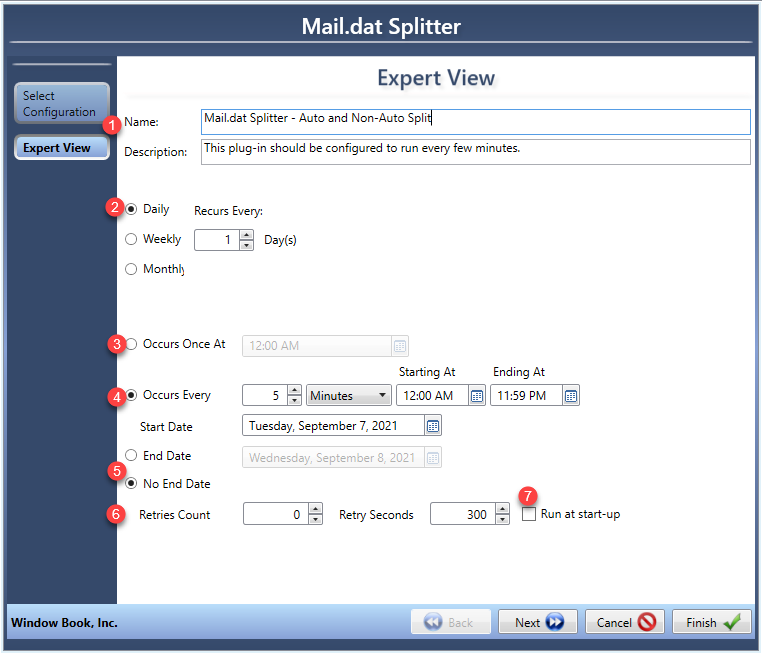
 Recurs every: The default is Daily; leave this setting unless you prefer not to have the Scheduler running every day, then you could change it to Weekly and select the days of the week it should be looking for Mail.dats.
Recurs every: The default is Daily; leave this setting unless you prefer not to have the Scheduler running every day, then you could change it to Weekly and select the days of the week it should be looking for Mail.dats. Occurs Once At: If you only want to look for Mail.dats once a day at a set time, you would select the time here.
Occurs Once At: If you only want to look for Mail.dats once a day at a set time, you would select the time here. Occurs Every: The default is 5 minutes and the Starting At 12:00 AM and Ending At 11:59 PM. You can adjust to suit your environment. For example, if you run a nightly backup, you change the Starting At and Ending At to ensure the Scheduler is not running.
Occurs Every: The default is 5 minutes and the Starting At 12:00 AM and Ending At 11:59 PM. You can adjust to suit your environment. For example, if you run a nightly backup, you change the Starting At and Ending At to ensure the Scheduler is not running. End Date and No End Date: The default is No End Date. If you are using this configuration for a specific project and after this time you do not want this configuration to run, you could set an End Date. Also, if you are making changes to a configuration, we have you set the End Date, so you can make the changes without stopping the Scheduler from running other plug-ins.
End Date and No End Date: The default is No End Date. If you are using this configuration for a specific project and after this time you do not want this configuration to run, you could set an End Date. Also, if you are making changes to a configuration, we have you set the End Date, so you can make the changes without stopping the Scheduler from running other plug-ins. Retries Count and Retry Seconds: Unless a Window Book Support Representative asks you to set a retry count and wait (seconds) until it tries again, please do not change.
Retries Count and Retry Seconds: Unless a Window Book Support Representative asks you to set a retry count and wait (seconds) until it tries again, please do not change. Run at Startup: Never select this option unless a Window Book Support Representative asks you to do so.
Run at Startup: Never select this option unless a Window Book Support Representative asks you to do so. -
The Folders screen will display.This screen requires you to create a series of folders that the plug-in process and the post presort software will monitor. When setup is complete, click Next to continue.
If you use DAT-MAIL, these folders should be created under the ‘WB’ folder on the computer or server, which is where DAT-MAIL’s data folders reside, within a directory specific to the plug-in (MDSplitter). If there will be multiple splitters setup, create subfolders under the MDSplitter folder, for example '...\WB\MDSplitter\MDSplitterAutoNonAuto'
If there will be multiple splitters setup, create subfolders under the MDSplitter folder.
In a server-with-workstations environment, use UNC paths when specifying file folders. In addition, create/use file folders located within a shared and available directory. For example, Window Book recommends creating folders within the main ‘WB’ directory. For assistance with UNC Paths, see the Support Portal Knowledge Base - https://windowbook.na2.teamsupport.com/knowledgeBase (login is required).
If the Client does not use DAT-MAIL, then the folders can be created on the root directory of the computer or server. However, in a server-with-workstations environment, these folders will need to be shared so that all workstations that have the post presort software installed will have access to them.
Below the print screen is an explanation:
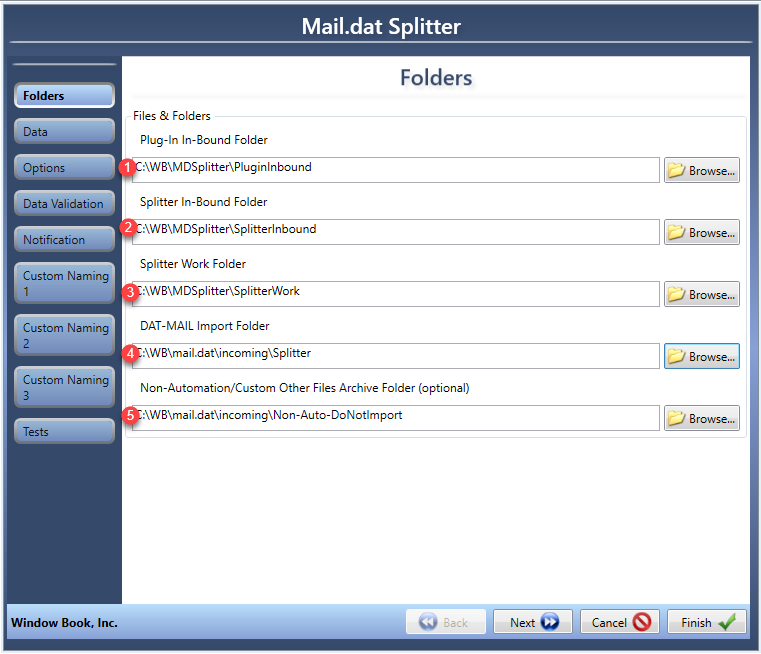
 Plug-In In-Bound Folder: This folder is where the Mail.dat files (in .zip file format) are placed. The plug-in monitors it.
Plug-In In-Bound Folder: This folder is where the Mail.dat files (in .zip file format) are placed. The plug-in monitors it. Splitter In-Bound Folder: This folder is where the .zip files found in the PluginInBound folder are moved. After moving them, the plug-in unzips them and begins processing the individual Mail.dat files. If the processing fails, the source Mail.dat zip file is moved to a ‘Rejected’ sub-folder automatically created by the plug-in.
Splitter In-Bound Folder: This folder is where the .zip files found in the PluginInBound folder are moved. After moving them, the plug-in unzips them and begins processing the individual Mail.dat files. If the processing fails, the source Mail.dat zip file is moved to a ‘Rejected’ sub-folder automatically created by the plug-in. Splitter Work Folder: When processing is successful, files found in the SplitterInbound folder are moved to this folder, at which time the functions selected or enabled in the Options screen are performed, and files are split.
Splitter Work Folder: When processing is successful, files found in the SplitterInbound folder are moved to this folder, at which time the functions selected or enabled in the Options screen are performed, and files are split. DAT-MAIL Import Folder: When files are split in the Splitter Work Folder, the .zipped file, depending on how they are split, are moved to the folder specified for importing into DAT-MAIL, where AWAM picks them up for importing into DAT-MAIL.
DAT-MAIL Import Folder: When files are split in the Splitter Work Folder, the .zipped file, depending on how they are split, are moved to the folder specified for importing into DAT-MAIL, where AWAM picks them up for importing into DAT-MAIL. Non-Automation/Custom Other Files Archive Folder (optional): This is a folder for non-automation files. For example, Auto/Non-Auto Split type, Non5D split files, and Custom Other or the Custom Tray Level split type files to separate them from the automation split files. In the example above, a folder was created called NonAuto-DoNotImport as a subfolder of Incoming.
Non-Automation/Custom Other Files Archive Folder (optional): This is a folder for non-automation files. For example, Auto/Non-Auto Split type, Non5D split files, and Custom Other or the Custom Tray Level split type files to separate them from the automation split files. In the example above, a folder was created called NonAuto-DoNotImport as a subfolder of Incoming.Refer to the Options screen, precisely the information provided on the Split Process options for information on how files are split and how they will be identified.
-
The Data screen will display. If the presort software does not include the Customer/Supplier Agreement (CSA) ID in the Mail.dat Segment file, it can be entered in the ‘Customer/Supplier Agreement (CSA) ID (optional)’ field. The Mail.dat Splitter plug-in will include it in the split Mail.dat Segment (SEG) files. Click Next to continue.
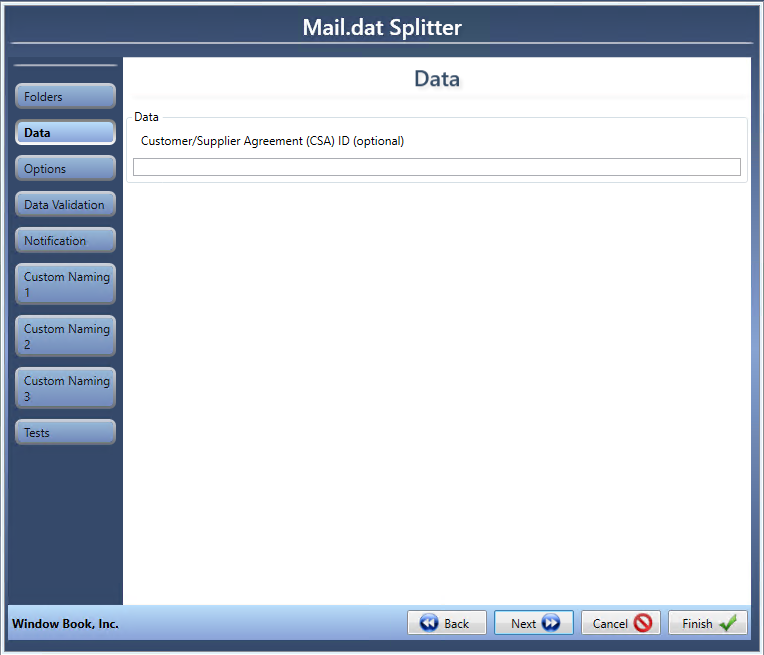
-
The Options screen will display. The options screen contains options/functions that can be applied to the split Mail.dat. When setup is complete, click Next to continue.
An explanation of each option or function is shown below the print screen:
The description will start with the left column top to bottom and then move to the second column.
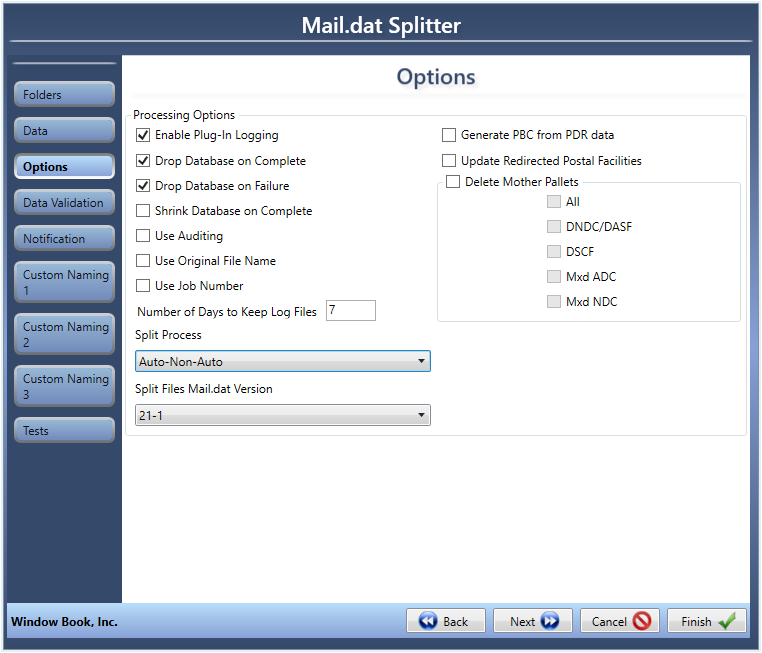
-
Enable Plug-in Logging: Select this checkbox to enable message logging to the Window Event log. This option is typically checked for technical support purposes only.
-
Drop Database on Complete: Select this checkbox to remove the temporary SQL Server database after processing has successfully finished.
-
Drop Database on Failure: Select this checkbox to remove the temporary SQL Server database after processing has unsuccessfully finished.
-
Shrink Database on Complete: Select this checkbox to shrink the temporary SQL Server database size after processing has finished.
-
Use Auditing: Select this checkbox to enable message logging to the SQL Server database.
-
Use Original File Name: Select this checkbox to prefix the split Mail.dat names with the name of the source Mail.dat zip file.
-
Use Job Number: Select this checkbox to prefix the split Mail.dat names with the job number of the source Mail.dat zip file.
-
Number of Days to Keep Log Files: Enter a value representing the number of days the Mail.dat Merger plug-in will keep the log files generated by the MDR Client read by the plug-in. However, the number of these log files can become quite large and slow processing down. The default retention period for log files is seven (7) days.
-
Split Process: Select how the file(s) should be split. Below is an explanation of the available options:
'Split name' refers to the file name of the split file. This is true for all the available splitter options.
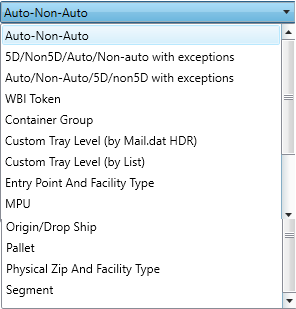
-
Auto-Non-Auto: Default Split Process option. Split source files into Automation trays and non-automation trays. The split name is 'Auto' for files containing automation trays and 'NonAuto' for files containing non-automation trays.
-
5D/Non5D/Auto/Non-Auto with exceptions: Used to split out mail sent to a commingler from mail; the commingler could not add any value. Ordinarily, this would mean keeping the 5-digit mail and giving the commingler everything else (Non-5-digit or Non5D). This option accomplishes this split.
When this option is selected, the screen updates to display a field to Enter Container level values (separate by comma), auto-populated with the default container values, but you can change if needed. The CSM container level values are used to identify the trays for commingling.

If this split option is selected, an exception list is created using a “wbMDAutomation.xml” file to identify excluded jobs (the exception list determines which customers get the Auto/Non-Auto split or are not split at all). This is saved in the Plug-in In-Bound folder along with the Mail.dat. Jobs to be split using the alternate process (Auto/Non-Auto) or not split are identified by the Client. The user defines who the Clients are in the .xml file.
When the 5D split is used, the files are named using the following format: '5D-<originalfilename>'. When the Non5D split is used, the files are named using the following format: 'Non5D-<originalfilename>'. First, non5D files are saved to the Non-Automation/Custom Other Files Folder. Then, 5D files are saved to the expected output folder.
-
Auto/Non-Auto/5D/non5D with exceptions: Used to mail all automation mail and give the non-auto mail to the commingler.
When this option is selected, the screen updates to display a field to ‘Enter Container level values,’ which is auto-populated with the default container values, but the user can change them if need be. The CSM container level values are used to identify the trays for commingling.

If this split option is selected, an exception list is created using a “wbMDAutomation.xml” file to identify excluded jobs (the exception list determines which customers get the 5D/Non5D split or are not split at all) that is saved in the Plug-in In-Bound folder along with the Mail.dat zip file. Jobs to be split using the alternate process (5D/non5D) or not split at all are identified by the Client. The user defines who the Clients are in the .xml file.
When the Non5D split is used, the files are named using the following format: “Non5D-<originalfilename>”. When the 5D split is used, the files are named using the following format: “5D-<originalfilename>”. First, non5D files are saved to the Non-Automation/Custom Other Files Folder. Then, 5D files are saved to the expected output folder.
-
WBI Token: This option allows you to split marketing mail between commingle and non-commingled drop ship. Tokens provide the ability to do both NDC and SCF 5D and also split out offshore. Split requirements are added to the HDR: UserOptionField.
-
-
Container Group: Split source files by Container Group ID. The split name is Container Group ID.
-
Custom Tray Level (by Mail.dat HDR): Split source files into automation trays at a particular presort level, and other automation and non-automation trays, using a user-supplied tray level code. The tray level code is supplied in the source Mail.dat’s Header (.HDR) file, within the ‘User Option’ field. When the ‘User Option’ field is set to ‘N,’ the source Mail.dat is moved directly to the DAT-MAIL import folder, as-is. The split name is “CustomAuto” for files containing specified automation tray level(s) and “CustomOther” for files containing remaining automation and non-automation tray levels.
-
Custom Tray Level (by List): Split source files by picking out MxADC and MxAADC trays to commail/commingle, removing those trays from the Mail.dat that is to be imported into DAT-MAIL with the MxADC/MxAADC trays put into a separate Mail.dat.
When this option is chosen, the screen will update and display a field where the user must enter a list of CSM Container Levels that they want to use to identify the trays for commingling. The field is auto-populated for the user; however, the values can be changed if necessary.

The Mail.dats comprised of MxADC/MxAADC trays are saved to the Non-Automation/Custom Other Files Folder. The remainder of the Mail.dat gets saved to the DAT-MAIL Input Folder.
-
Entry Point And Facility Type: Split source files by Entry Point and Facility Type. The split name is Entry Point ZIP + Facility Type code.
-
MPU: Split source files by Mailpiece Unit ID. The split name is Mailpiece Unit ID.
-
Origin/Drop Ship: When selected, this option will create two split files: one for Origin mail; and one for Drop Ship mail.
-
Pallet: Split source by mother pallet ID.
-
Physical Zip and Facility Type: Split source files by Physical ZIP and Facility Type. Split name is Physical Plant ZIP + Facility Type code; and
-
Segment: Split source files by Segment ID. The split name is Segment ID.
-
Split Files Mail.dat Version: Select the Mail.dat version number for the split files.
If submitting the merged file to PostalOne!, make sure to use a version their system accepts. See the most current USPS Technical Specification for Mail.dat.
-
Generate PBC from PDR data: Select this checkbox to generate PBC from the PDR data.
-
Update Redirected Postal Facilities: Select this checkbox to enable updating the redirected postal facilities.
-
Delete Mother Pallets: Select this checkbox to delete mother pallets. Select the checkbox for what types to delete: All, DNDC/DASF, DSCF, Mxd ADC, or Mxd NDC.
-
-
The Data Validation screen will display. When ready, click Next to continue.
An explanation of each option or field is shown below the print screen::
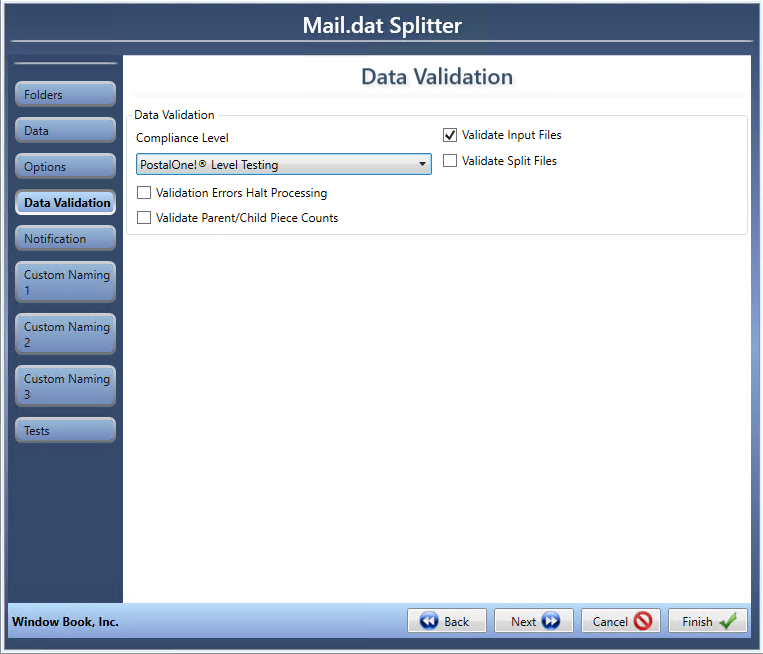
-
Compliance Level: Select a compliance level from the drop-down to be applied to the Mail.dat files.
- None: No compliance validation is done on the Mail.dat data.
-
Referential Integrity Only: Record counts as reported in the HDR fields checked against other files.
-
Field Level Validation: Basic field content checks (in addition to Referential Integrity checks), including justification. For example, numeric fields should only contain numbers.
-
Mail.dat Conformance Testing: In addition to performing the Field Level Validation checking, the fields are evaluated based upon values that are generally known to be valid for these fields (HDR PQT File Status should be one of O, D, R, N, C, U). The validation may take into consideration other related values. For example, to determine the list of valid zones for the CQT Zone, one needs to consider Class Defining Preparation. If it is Periodicals, we also need to know the CQT 3-Digit /5-Digit Container divisions and the CQT Not County/ In County indicator. Required fields are also checked to make sure they are not omitted.
-
PostalOne!® Level Testing: Fields required by PostalOne! are included. The Conformance tests are performed, and additional fields for PostalOne! are added into the required or not list.
-
Validation Errors Halt Processing: Select this checkbox to have the Splitter processing stop after validation errors are encountered.
-
Validate Parent/Child Piece Counts: Select this checkbox to have the Splitter validate that child aggregate piece counts match the parent piece count (for example, aggregate CQT piece count matches parent CSM piece count).
-
Validate Input Files: Select this checkbox to stop the Splitter processing after validation errors are encountered.
-
Validate Split Files: Select this checkbox to have the Splitter validate the split Mail.dats (output files).
-
-
The Notification screen will display. This feature provides automatic notifications to a group of people via email when the plug-in runs and the process completes without encountering errors (Send on success). Plus, show when the process is incomplete (Send on failure). Click Next to customize names for split files. If no customization is required, click Finish to complete the setup.
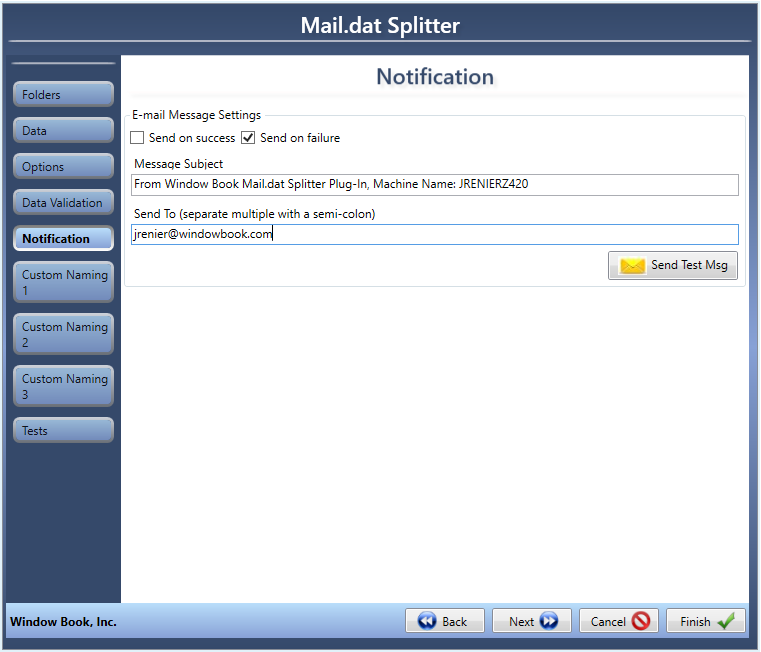
-
The Custom Naming 1, after clicking Next, two more custom screens will display. Custom Naming can be used to insert specific text in the names to the split files. This text will appear in addition to the split name as described in the ‘Split Process’ section of the Options screen discussed in Step 6. Split Process. In the Custom Naming 2 and Custom Naming 3 screens, any text added or specified will be appended to the values or data entered in the previous screen. For example, if using all custom naming screens - whatever text is added or specified here will be appended to Custom Naming 1 and Custom Naming 2 screens. Click Next after setting up Custom Naming screens, or click Next to move past them.
A description of each field is shown below the print screens:
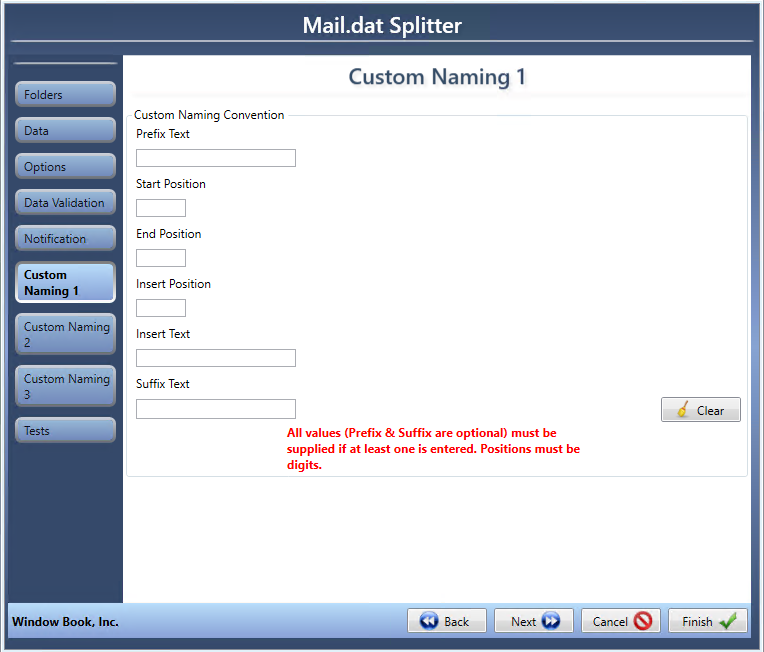
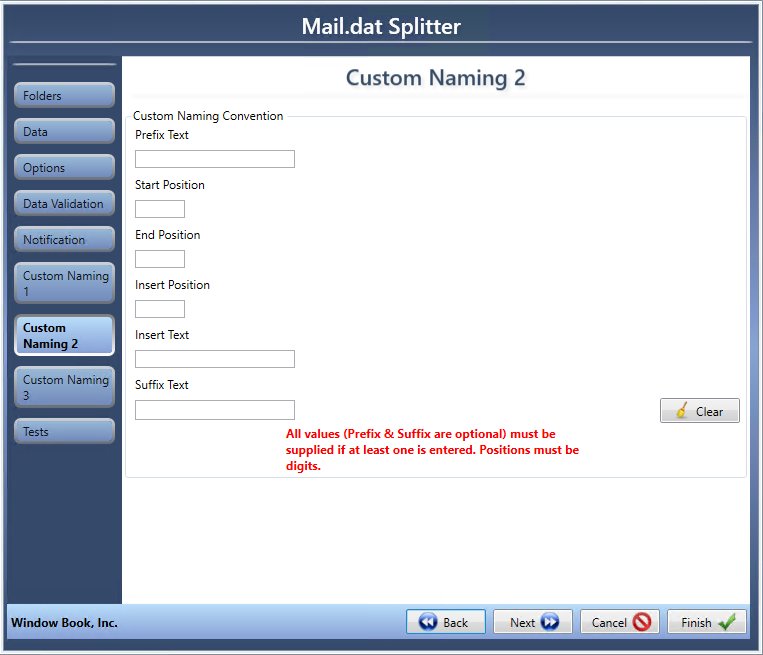
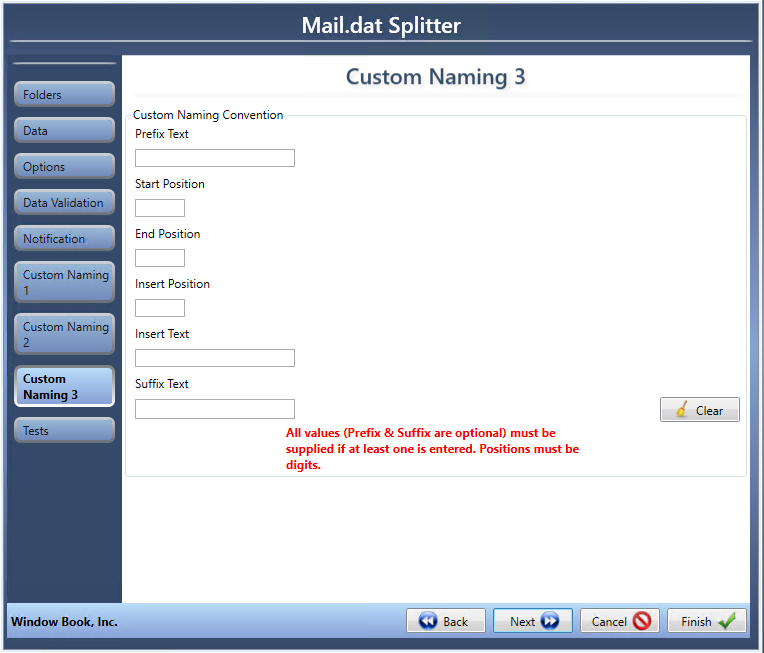
-
Prefix Text: Input optional text to prefix to the split name portion of the split Mail.dat names.
-
Start Position, End Position, and Insert Position: Enter numerical values into each field to determine at which point in the split portion of the file name the specified text is inserted.
-
Insert Text: Input optional text to insert into the split name portion of the split Mail.dat names.
-
Suffix Text: Input optional text to append to the split name portion of the split Mail.dat names.
-
Clear: Click to clear all of the data entered into each of the fields.
Custom Naming only affects the split name portion of the file names. Therefore, if the original file name or job number is used in the split file names, these text strings are unaffected by Custom Naming.
-
-
The Tests screen will display. Select the Run configuration tests the next time plug-in runs checkbox (optional). The test results from the previous test run will display in the Previous Configuration Test Results window. Click Finish.
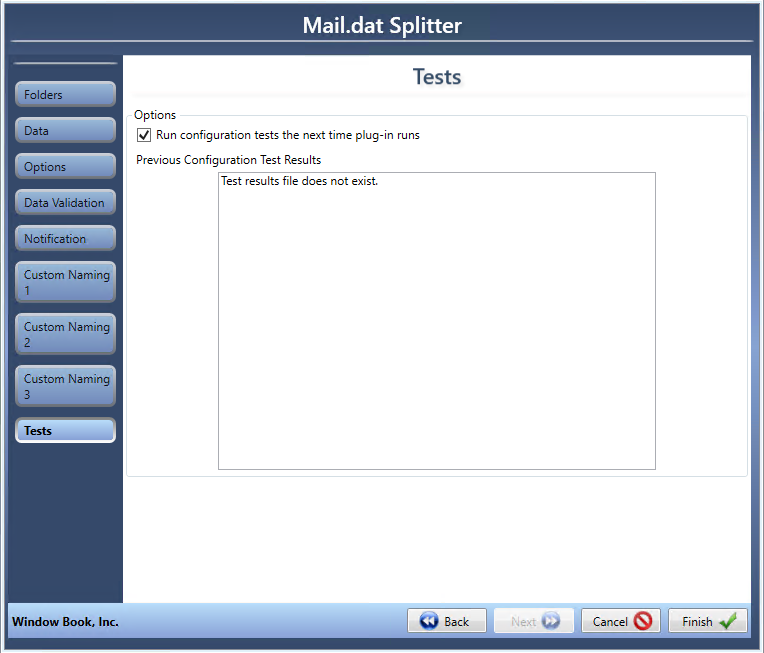
-
The Finished screen will display. Start
 the service, if finished with setting up plug-ins. Also, Scheduler can be closed.
the service, if finished with setting up plug-ins. Also, Scheduler can be closed. 
Plug-Ins Available